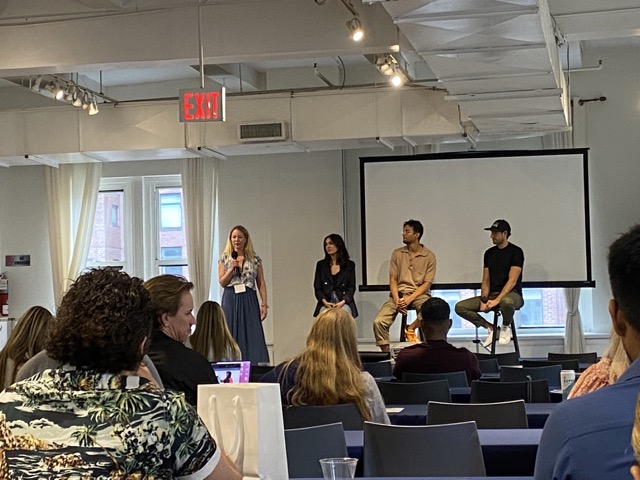Recently, I was fortunate enough to spend a lovely and rewarding day in New York attending the ChargeUp event hosted by Recharge. This was my first event since the pandemic began, and it will not be my last. With the inspiring thought-leadership (and impressive hors d’oeuvres pictured below!), Recharge has proven to be truly apt in their event planning in the new post-pandemic tide.
After checking in, I was met with accessible high-top tables and enjoyed delicious breakfast items (most importantly; Coffee).
Welcome & State of the Industry // Recharge Product Roadmap
Led by the VP of Strategic Alliances, Lindy Crea, we discussed how undeniably there has been a spike in ecommerce growth during the lockdown, and we’re now seeing the gradual descent as we settle back to stasis. In addition to this, merchants are facing supply chain issues and clogged shipping channels, which has disrupted a significant amount of delivery flows.
The supply chain is not just backlogged, but it is getting more expensive. Customer acquisition cost continues to increase in the “cookie-pocolypse” causing merchants and consumers alike to pull back from social spend.
This has made the need for reliable revenue evermore evident for merchants.
Succeed with Subscriptions: Attract Subscribers
We then broke out to discuss one of the foundations of reliable revenue and successful, scalable, business being on customer retention, the marketing track led by Christy Ottesen, Senior Product Marketing Manager. One of the foundations of the panel; 32% of customers are prepared to abandon their loyalty to a company after one very bad experience. In a very interesting correlation, 80% of stores feel they’re delivering a great customer experience, where only 8% of customers feel they’re receiving a great experience.
 Customer Experience (CX)
Customer Experience (CX)To add more on a merchant’s plate, buy online, pickup in-store (BOPIS), is forecast to grow by 19.3% by 2027. Whether or not this is already cultivated, this will grow into a more significant vertical for merchants as the post-pandemic stasis levels out.
Finally, research has shown that through conditioning from big league experiences such as Disney, consumers will be expecting the utmost in response time and excellent customer service. As a merchant, you are expected from customers to perform within the same parameters as those big leagues with your customer experience. So, customers are not only expecting you to outperform your competitors, but they’re expecting you to provide the same level of customer service as a multi-level, thousand-employee-marketing-team, with granular operations, and nearly 100 years of honed experience.
 I know. Like, what? How the heck are you supposed to do that?
I know. Like, what? How the heck are you supposed to do that?There is a ton of strategy around the best CX, and this will change as the market does. Recharge has broken it down into three major principles:
- Speed
- Convenience
- Friendliness
Speed: Attentiveness in responding to your customers is key to making them feel heard and understood. Recharge has partnered with Gorgias to serve and resolve subscription questions faster. This integration allows the sales team to re-active, refund, or cancel subscriptions all within the same window, so there is no need to switch between tools.
Convenience: RechargeSMS is a free tool for Recharge merchants that allows for subscription management through customer self-service via SMS. Providing the flexibility for customers to manage their own subscription dramatically increases customer lifetime value (CLV). All functions of the customer portal can be completed via text and this tool has proven to increase CLV up to 30%.
Friendliness: Providing an excellent customer experience on an omnichannel strategy is key to retention. Average customer behavior has been proven to pay a premium for additional benefits such as early access, a customized experience, and long-term discounts.
Understandably, lunch was buzzing with subscription strategy conversations and methods to increase retention, and decrease churn. I discussed a few areas of nuance with merchants of varying demographics such as customizations for subscription-pause, specifically around the school year, and how to automatically resume after summer and winter breaks. I also discussed how difficult the transition can be from WooCommerce to Shopify Plus without support, and how to decrease the churn that comes with customers needing to enter additional information or create a whole new profile on a new platform.

This event quickly made me realize that as our tech partners here at Ambaum begin to scale, these merchant needs are where our services can really step in to help. Through years of agency experience with over 30 active merchants, we are able to quickly identify this low-hanging fruit to then build long-term solutions and strategies for the merchant’s success. By working with many of our preferred partners within the first few years of their conception (Recharge for 4+ years!), we are able to travel parallel with their updates, step in, and solve these types of customizations that merchants need.
Case Study: Optimize your Subscription Business with Customization and Integrations // Happy Hour
The conference ended with a case study between Klaviyo, Wandering Bear Coffee, and their Shopify tech agency, where we covered their transition into e-commerce over the pandemic. Taking on Klaviyo for email and SMS, the merchant was able to take their sales to a new level. As Recharge provided the flexibility for customers to manage their own subscription, they saw their CLV soar. Through this panel discussion we answered the question: When do you start the conversation with your customers? The answer: Either now, or yesterday.

After wrapping up the conference, we finished with a happy hour on the terrace rooftop, and plenty of in-depth discussion about what is on the horizon for subscription services. Recharge has new updates upcoming including a way to understand the entire customer experience in a single view, data consistency between Recharge and Shopify where you can perform bulk discount imports with one click, and a widget for Shopify Plus for an incredibly easy subscription service setup. As these updates roll out, you can be sure we’ll cover them here, so sign up for our newsletter now (if you haven’t already!).
Conclusion
I thoroughly enjoyed the day from the organized setup, to discussing poignant thought-leadership with peers and partners over the bustling city below. I look forward to the next event with our partners here at Ambaum, and new updates from our partnership with Recharge.






